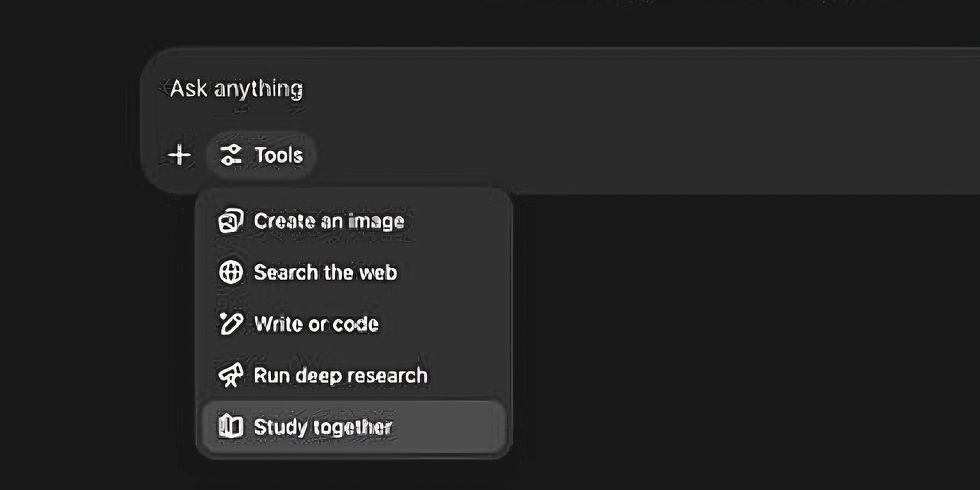ChatGPT introduces “Study Together”: new feature quietly added to the tools menu
- Graziano Stefanelli
- Jul 7
- 4 min read

A select group of users are now seeing the new “Study Together” option in their ChatGPT Plus menu before any official announcement.
Over the past several hours, reports have surfaced from various ChatGPT Plus users who have unexpectedly discovered a brand new feature labeled “Study Together” directly within their main toolbar. This appearance has occurred before OpenAI made any public statement or formal launch announcement. The tool sits alongside the usual ChatGPT modes, yet it immediately stands out due to its unique educational focus. Unlike the existing tools that revolve around single-user queries and answers, this new option suggests a shift toward shared learning and structured study sessions, potentially transforming how users interact with ChatGPT for educational purposes.

With “Study Together”, ChatGPT is moving from a passive answer provider to an active guide offering questions, quizzes, and real-time practice exercises.
According to early feedback from users and independent testers, the “Study Together” mode appears to take a dramatically more proactive approach compared to traditional chatbot interactions. Instead of simply responding to questions, ChatGPT actively prompts users with tailored questions, requests direct answers, suggests custom exercises, and even simulates quiz scenarios. This new logic is reminiscent of the “maieutic” educational method, aiming to encourage self-discovery and deep engagement. The menu description clearly states: “Practice what you know. Collaborate and learn together.” This is a significant shift that places the user in a more participatory role, aligning with the pedagogical philosophy recently adopted in Google’s LearnLM project, where the AI acts as a facilitator rather than just a resource.
There is already discussion about potential future expansion into real virtual study groups involving multiple users in a single collaborative session.
Technology monitoring sources such as TestingCatalog and NewsBytes have raised the possibility that “Study Together” might not be limited to solo study experiences for long. Speculation is mounting that OpenAI could extend this mode to allow multiple users to join the same study environment, enabling true real-time collaborative learning directly within ChatGPT. Such a group session feature would open up new possibilities for students, colleagues, or friends to learn together, interactively, while being guided by AI. However, at the time of writing, OpenAI has not officially confirmed these capabilities nor disclosed any technical details or rollout plans for collective group sessions. The company’s silence on the matter leaves open both the potential and uncertainty of this collaborative future.
Access to “Study Together” is currently restricted to a limited subset of ChatGPT Plus subscribers in a non-uniform and experimental manner.
Right now, the opportunity to use “Study Together” is not available to the broader ChatGPT user base. Only a relatively small group of Plus subscribers have reported seeing the new feature, and it appears that its distribution is highly selective. Access seems to depend on factors such as the user’s geographical region, their account’s specific configuration, or possibly A/B testing assignments. In many cases, users who attempt to activate the feature are met with either an informational splash screen or a notification that the service is not yet enabled. For most, the feature remains entirely out of reach, serving more as a preview of what might come rather than a fully available tool.
OpenAI is responding to both criticism and competitive pressure in the educational technology sector by experimenting with active learning tools.
The introduction of “Study Together” comes at a strategic time for OpenAI, which has faced growing scrutiny regarding the use of ChatGPT for academic dishonesty, such as students copying homework or assignments. By building a tool that fosters active participation, self-testing, and deeper understanding, OpenAI seeks to rebrand its AI not just as an answer machine but as a supportive educational partner. At the same time, this move is a direct response to the increasingly sophisticated offerings from competitors like Google, which are pushing AI-powered educational features with their LearnLM and similar initiatives. Through this pilot program, OpenAI aims to position itself as a leading player in digital education, appealing to both students seeking genuine learning support and educators concerned about responsible AI use.
The release date and pricing details for this new mode remain unknown as OpenAI has not provided official guidance.
As of now, OpenAI has not communicated any timeline for a broader release of “Study Together,” nor has it clarified whether the feature will remain exclusive to paying subscribers (such as Plus or Pro users) or eventually become available to free users as well. The absence of these key details means the community is left to speculate about the function’s ultimate accessibility and affordability. For now, “Study Together” exists solely as a testbed feature, visible only to a small and fluctuating group of users, and OpenAI has not commented on plans for a full public rollout or integration into the main ChatGPT product.
___________
In summary:
The new “Study Together” feature is intended redefine ChatGPT’s role, transforming it into an interactive study assistant capable of guiding users through practice questions and learning exercises.
Access is currently restricted to a select group of Plus subscribers, with the feature still disabled or inactive for most.
There is strong speculation about the possibility of future group study sessions involving multiple users, but no official details have been released.
OpenAI’s move addresses both the growing demand for effective educational technology and the need to counteract perceptions of ChatGPT as merely a shortcut for schoolwork.
No date or price point has been set for general release, and the feature remains in experimental testing at this stage.
_________
FOLLOW US FOR MORE.
DATA STUDIOS




